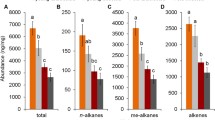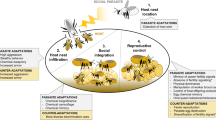Summary
The phenomenon of colonialism which characterizes many insect groups is considered in terms of its potential effect on intraspecific competition. Intraspecific competition is assumed to be a function of the number of distinct pair encounters between 2 individuals of differing colony origin. A model is offered which describes the reduction in the number of potential competing encounters as a result of colonialism, and as such, combinatorial formulae are appropriate. For 2-colony and multi-colony systems, there is a proportionately smaller number of potential competing encounters as the size of the colonies becomes more inequitable and greater than 100 individuals in combined total. As a consequence, large inequitabilities in colony sizes are expected for nearest neighbor pairs, and thus a generally large variance in colony size for groups of colonies is also expected. Empirical data from various sources is presented and in good agreement with the predictions generated from the model.
Similar content being viewed by others
References
Brian, M. V., Hibble, J., Stradling, D. J.: Ant pattern and density in a southern English heath. J. anim. Ecol. 34, 545–555 (1965)
De Vita, J.: Competitive and interactive mechanisms among colonies of the harvester ant Pogonomyrmex californicus in the Mojave Desert, California., Ph.D. Thesis, University of Southern California, Los Angeles, 115 pp. (1975)
Hamilton, W. D.: The genetical evolution of social behavior. I. J. theor. Biol. 7, 1–16 (1964a)
Hamilton, W. D.: The genetical evolution of social behavior. II. J. theor. Biol. 7, 17–52 (1964b)
Hamilton, W. D.: Selection of selfish and altruistic behavior in some extreme models. In: J. F. Eisenberg, W. S. Dillon, eds., Man and beast: comparative social behavior, p. 59–91. Washington, D. C.: Smithsonian Press 1971
Hamilton, W. D.: Altruism and related phenomena, mainly in social insects. Ann. Rev. Ecol. Syst. 3, 193–232 (1972)
Michener, C. D.: Comparative social behavior of bees. Ann. Rev. Entomol. 14, 299–342 (1969)
Odum, E. P.: Fundamentals of ecology, 3rd ed., 574 pp. Philadelphia: Saunders 1971
Park, T.: Experimental studies of interspecies competition. II. Temperature, humidity, and competition in two species of Tribolium. Physiol. Zool. 27, 177–238 (1954)
Pickles, W.: Populations, territory and interrelations of the ants Formica fusca, Acanthomyops niger and Myrmica scabrinodis at Garforth (Yorkshire). J. anim. Ecol. 4, 22–31 (1935)
Pickles, W.: Populations and territories of the ants, Formica fusca, Acanthomyops flavus, and Myrmica ruginodis, at Thornhill (Yorks). J. anim. Ecol. 5, 262–270 (1936)
Schoener, T.W.: Population growth regulated by intraspecific competition for energy or time: some simple representations. Theoret. Pop. Biol. 4, 56–84 (1973)
Williams, G. C., Williams, D.C.: Natural selection of individually harmful social adaptations among sibs with special reference to social insects. Evolution 11, 32–39 (1957)
Wilson, E. O.: The social biology of ants. Ann. Rev. Entomol. 8, 345–368 (1963)
Wilson, E. O.: The insect societies, 548 pp. Cambridge: Harvard University Press 1971
Wilson, N. L., Dillier, J. H., Markin, G. P.: Foraging territories of imported fire ants. Ann. entomol. Soc. Amer. 64, 660–665 (1971)
Wynne-Edwards, V. C.: Animal dispersion in relation to social behavior, 653 pp. London: Oliver and Boyd 1962
Author information
Authors and Affiliations
Rights and permissions
About this article
Cite this article
De Vita, J. Insect sociality and its consequential effects on intraspecific competition. Oecologia 20, 129–133 (1975). https://doi.org/10.1007/BF00369025
Received:
Issue Date:
DOI: https://doi.org/10.1007/BF00369025




